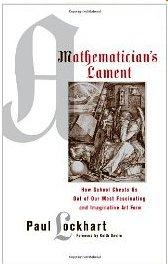Rocks in My Head
By Peter LloydAuthor Paul Lockhart speaks to me where I live. He's written a book titled A Mathematician's Lament. I only read about the book in an article, "Rock Groups" by Steven Strogatz. But I've had rocks in my head ever since. That is, I've been thinking about numbers in a fascinating new way.
 According to Strogatz, Lockart says we might want to teach math using a more concrete method. He proposes using rocks rather than numbers as abstract entities. In a way he's suggesting play in place of brain-grueling abstraction and memorization in math class. Hooray for Lockhart!
According to Strogatz, Lockart says we might want to teach math using a more concrete method. He proposes using rocks rather than numbers as abstract entities. In a way he's suggesting play in place of brain-grueling abstraction and memorization in math class. Hooray for Lockhart!I know my times tables pretty well now, but I wonder how I did it. What a drudgery in a time when I was supposed to be having fun exercising my creativity rather than my left-brain machinery. Or at least flexing one along with the other. Like you, I flourished when I set out to learn what I understood the point of. What's the point of memorizing six times seven to grade-schooler?
I would have loved Lockhart's rock-group approach to math. And when I play with it these days, I'm reminded of how much I love numbers. That's right. I still hate to add, subtract, multiply, and divide them the way I was taught, but I love to play with them and I always did. In fact, since school, I've devised better ways to do number operations in my head. On my own, out of sheer necessity. But I've come up with nothing as tactile and visual as Lockhart's rocks.
Here are just a few examples of Lockart's approach:
Pick a number, any number, and arrange that number of rocks in different kinds of groups. Not in your head but with real rocks. It's easier, of course, to start with smaller numbers, like one through ten. But you figured that out already. And I'm sure you realize you don't have to use rocks either. See, it's working already. You're starting to create your own way to do this!
In any case, you'll soon discover that some numbers let you form perfectly square arrangements. The only two such number groups between one and ten are: four and nine. Viola! We call these square numbers. Nine forms a square set of rocks or, you could say, it's a square number, which ever way you prefer to think about it. But isn't it more fun to think of nine as a square of rocks? It's certainly more visual.
Try this: Add any series of consecutive odd numbers starting with 1. Oops! I'm beginning to sound like a math teacher. Just add odd numbers starting with one. Don't skip any. Stop whenever you feel like it. 1 + 3 + 5, or 1 + 3 + 5 + 7, and so on. Whenever you stop, you always get a square number. Cool! But the really big insight comes when you do this with rocks, because you see why. Will this hold true all the way to infinity? How many rocks you got?
Working with rocks, you might learn that any group that forms a rectangle is an even number. That's because these rectangles are built on rows of even numbers. An even plus an even always equals an even. Remember? Now you see why. On the other hand, odd numbers are rectangles with an odd rock sticking out, and when you put the sticking-out ends of some rectangles together, you get a new rectangle. Of course! Odd plus odd equals even. You knew that, but now you have a picture and a concrete way to represent it.
Lockhart is really on to something that we who promote creativity have advocated forever. Namely, that play in the name of learning is not only more fun, it yields deeper understanding and greater appreciation of the learned material. He's done a brilliant job of recommending that students play and create their own ways to understand and manipulate numbers.
Rock on, Lockhart!
Read A Mathematician's Lament: How School Cheats Us Out of Our Most Fascinating and Imaginative Art Form
"Rock Groups" author Steven Strogatz lists several more books that explore this subject.
Peter Lloyd is co-creator with Stephen Grossman of Animal Crackers, the breakthrough problem-solving tool designed to crack your toughest problems.
